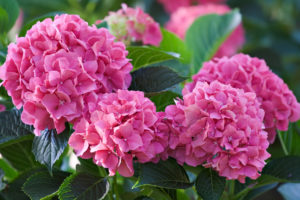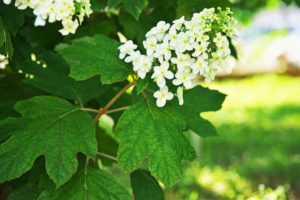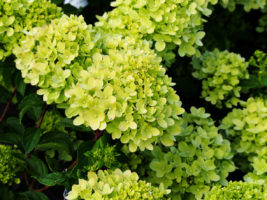The Challenges and Rewards of Hydrangeas
All gardeners know the feeling of deep-seated jealousy that sting the heart when they see a plant – maybe in a magazine, maybe while on vacation – and want it for their own garden, even when they know it will be hard to grow.

North Texas gardeners are often struck by raging cases of plant envy when they see enormous hydrangeas in cooler, wetter parts of the world. Growing up to 15 fee tall and around, these shrubs can be found covered with clusters of pure pink or deep blue blooms.
“I love hydrangeas, but it’s hard to grow those big, colorful ‘mophead’ hydrangeas in Tarrant County,” said Senior Horticulturalist Steve Huddleston. “They need lots of water, and they suffer in our heat.”
But you don’t need to resign yourself to plant envy. With the right variety of hydrangea, the right location, and the right care, you can indulge your love of hydrangeas right here in North Texas.
Three species of hydrangeas are generally available in Tarrant County:
 Hydrangea macrophylla is the “mophead” hydrangea that thrives in cooler climates. They are often sold in pots in the spring for Mother’s Day. While gorgeous, they are a challenge to grow in our climate. Even with lots of water, their flower heads are small, and their leaves often look droopy. These hydrangeas prefer an acidic soil, which is rate in our area. Some parts of the county have sandy, slightly acidic soils where hydrangeas will do fairly well, particularly if the soil is amended with lots of compost to increase moisture retention. However, most of the county has alkaline, clay soils; these will need substantial additions of sphagnum peat moss and finely ground pine bark mulch. They also like well-drained soils. Hydrangeas need shade and will burn up in direct sunlight. Dappled morning sun is tolerable, but afternoon shade is essential.
Hydrangea macrophylla is the “mophead” hydrangea that thrives in cooler climates. They are often sold in pots in the spring for Mother’s Day. While gorgeous, they are a challenge to grow in our climate. Even with lots of water, their flower heads are small, and their leaves often look droopy. These hydrangeas prefer an acidic soil, which is rate in our area. Some parts of the county have sandy, slightly acidic soils where hydrangeas will do fairly well, particularly if the soil is amended with lots of compost to increase moisture retention. However, most of the county has alkaline, clay soils; these will need substantial additions of sphagnum peat moss and finely ground pine bark mulch. They also like well-drained soils. Hydrangeas need shade and will burn up in direct sunlight. Dappled morning sun is tolerable, but afternoon shade is essential.
The blooms of the plants are pink in more alkaline soils and blue in acidic soils. In alkaline soils, you can apply aluminum sulfate to the soil to produce blue flowers. It’s important to know that Hydrangea macrophylla blooms on “old wood.” For this reason, do not prune during the winter. Which would remove the flower buds for the spring. Prune only after spring blooming is finished.
Hydrangea macrophylla also comes in a “lace-cap” form, which is very attractive. “Endless Summer” is a popular cultivar available in multiple colors. All H. macrophylla require heavy watering, especially in the hottest days of the summer.
 Hydrangea quercifolia, or oakleaf hydrangea is the best choice for hydrangea lovers looking for a less demanding plant. Native to the southeastern U.S., these plants are shrubs that grow up to six feet tall and six feet wide. In spring, they are covered with large cones of white blooms. Large oak-leaf shaped leaves provide texture in the summer and turn vivid red in the fall. When the leaves fall, the cinnamon-colored bark continues to stand out.
Hydrangea quercifolia, or oakleaf hydrangea is the best choice for hydrangea lovers looking for a less demanding plant. Native to the southeastern U.S., these plants are shrubs that grow up to six feet tall and six feet wide. In spring, they are covered with large cones of white blooms. Large oak-leaf shaped leaves provide texture in the summer and turn vivid red in the fall. When the leaves fall, the cinnamon-colored bark continues to stand out.
The plant requires well-drained, moist soil. Help keep the soil evenly moist by applying two inches of hardwood mulch around the shrub. Oakleaf hydrangeas prefer shade and will not tolerate afternoon sun.
 Hydrangea paniculata is not as demanding as H. macrophylla but not as easy as oakleaf hydrangeas. Sometimes called hardy hydrangea, they are more tolerant of heat and direct sunlight, although they still need afternoon shade. Good drainage is a must, but the plants tolerate a range of pH levels. Popular cultivars include “Limelight” (lime green to white flowers) and “White Wedding” (white flowers).
Hydrangea paniculata is not as demanding as H. macrophylla but not as easy as oakleaf hydrangeas. Sometimes called hardy hydrangea, they are more tolerant of heat and direct sunlight, although they still need afternoon shade. Good drainage is a must, but the plants tolerate a range of pH levels. Popular cultivars include “Limelight” (lime green to white flowers) and “White Wedding” (white flowers).
Hydrangeas are not for everyone, and alternatives are available that will thrive in your landscape. Consider the following:
- Abelia: There’s an abelia of every size and for every situation, and all tolerate our heat and dry conditions. They need full sun to perform well, although they will take light shade. The plants feature white, bell-shaped flowers on an evergreen shrub. Look at varieties including “Kaleidoscope,” “Radiance,” “Bella Donna,” and “Magic Daydream.”
- Japanese Kerria: An excellent choice for shady spots! Yellow-orange, double flowers about the size of a quarter bloom in the spring even in full shade.
- Turk’s cap (Malvaviscus arboreus, var. drummondii): This native perennial blooms from spring until fall and is available in right, white, and pink varieties. Takes full sun or shade, but looks perkier in the shade, it is drought tolerant. Turk’s cap is perfectly happy in our thick clay soils and provides reliable color all summer long.
Growing hydrangeas requires a commitment that not all gardeners are ready to make – and that’s fine! But if you’re ready to take on the challenge, with the right variety and the right location, you can fill that hydrangea-shaped hole in your heart.


 Sign in
Sign in

